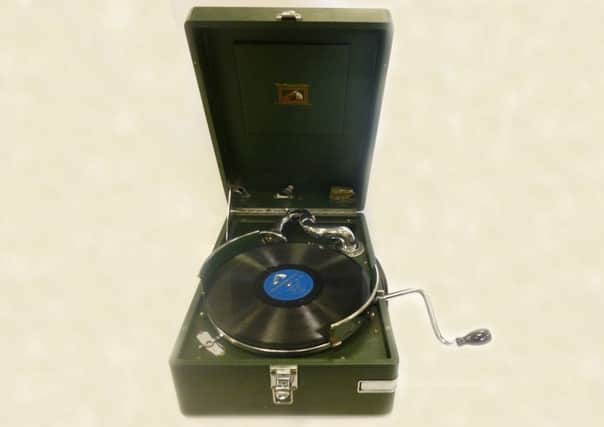Exhibit of the Week: HMV Gramaphone, Woodhams Stone Collection


The first machine to record and reproduce sound was the Phonograph, patented in 1878 by Thomas Edison. This early machine recorded the sound on cylinders covered with a layer of tinfoil which captured the sound vibrations via a stylus in indents along a groove. The tin Phonograph, however, was difficult to listen to and the foils were easily damaged. They were also impossible to copy. The next development was the Graphophone, patented in 1986 by Charles Sumner Tainter and Chichester Bell (cousin of Alexander Graham Bell, the inventor of the telephone). The recordings for the Graphophone were cut into wax covered cylinders instead of foil and were far better in quality. Edison rose to the challenge created by the Graphophone by producing the Perfected Phonograph in 1888. This used all-wax cylinders, each lasting about two minutes.
Both these rival machines were marketed as dictation machines. It was not until the 1890s that the companies began recording music. Arcades with coin-operated phonographs appeared and queues formed to hear recordings of popular songs. The public listened through hearing tubes which fitted in the ears. The quality of these cylinders was poor, but showmen found that they could make huge profits. Pre-recorded music had arrived.
Advertisement
Hide AdAdvertisement
Hide AdIn 1888 another type of sound machine was demonstrated. Invented by Emile Berliner, this new machine played recordings cut into flat discs. The sound recordings were cut through a layer of wax on a zinc base. The disc was then immersed in acid which ate into the metal, cutting a deep groove between the wax-protected areas. The zinc master record could then be used to make a metal matrix with a ridge in place of the groove. This in turn could be used to press hundreds of copies in any suitable material such as celluloid or vulcanite (a hard rubber). The playback machine or Gramophone had a stylus which simply followed the groove in the disc. These developments made the Gramophone and its recordings cheaper to produce than its earlier rivals. The sound was also louder, but to begin with it was no better.
As technology developed both machines and recordings improved. In 1900 solid wax blanks were introduced, improving the quality of recordings. Also, shellac replaced vulcanite, which was prone to warping.
In 1898 a branch of Berliner’s business, the Gramophone Company, opened in Covent Garden and in 1899 the company purchased the rights to the picture by Francis Barraud known as ‘His Master’s Voice’. Nipper, the terrier, had originally been depicted listening to a phonograph, but now he listened faithfully to an Improved Gramophone.
In 1931 the Gramophone Company merged with the Columbia Gramophone Company to form Electrical and Musical Industries Limited (EMI). From the 1930s the brand name HMV was used on their products.
Advertisement
Hide AdAdvertisement
Hide AdThe gramophone in the Woodhams Stone Collection is an HMV Model 102. This was a popular portable model produced between 1931 to 1958. This machine dates from the 1930s and the case is covered in a very fashionable green. It also boasts an additional record holder with raised sides which fits over the turntable. This was used to transport records safely and lifts off the turntable when the gramophone was in use.
It strangely does not look so old fashioned. In 2016, 3.2 million vinyl records were sold, a rise of 53% on the previous year, and vintage style record players have been popular for a few years now.